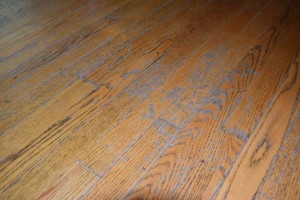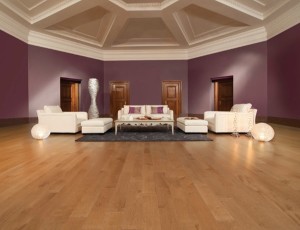How to Avoid Common Hardwood Flooring Mistakes
Posted by Aaron Schaalma
 When you’re in the business of installing and refinishing wood floors, you see a lot of commonly made mistakes among homeowners. Homeowners who, nine out of ten times, just lacked the proper knowledge and education to make a great decision when given the choice. The comfort you see in a customer when you tell him or her that you’ve had experience helping that same mistake before is immediate. We like to stay proactive, however.
Here are 4 common hardwood flooring mistakes made by homeowners and how to avoid them:
1. Choosing the wrong hardwood or finish
Just like any aspect of homeownership, buying the right material is crucial to making sure your hardwood floor lasts. Different floors are going to respond differently to things like pets (which we did a whole blog on here), mobile furniture (another blog), and even wear and tear from kids.
If you have large dogs, for example, a harder wood is going to be more scratch resistant than a softer wood. Likewise, a lighter wood with long graining will be less likely to show any scratches that are picked up.
If the floor is in a high-traffic area of the house, and especially if you have kids, a low-traction, glossy finish can be a quick road to owie town. It’s also more likely to show scratches should they occur in the course of play.
If you already have a glossy floor in such an area, finding an area rug that complements your room will help minimize the risk of injury to both children and floor alike (we wrote a blog about finding great area rugs here).
When you’re in the business of installing and refinishing wood floors, you see a lot of commonly made mistakes among homeowners. Homeowners who, nine out of ten times, just lacked the proper knowledge and education to make a great decision when given the choice. The comfort you see in a customer when you tell him or her that you’ve had experience helping that same mistake before is immediate. We like to stay proactive, however.
Here are 4 common hardwood flooring mistakes made by homeowners and how to avoid them:
1. Choosing the wrong hardwood or finish
Just like any aspect of homeownership, buying the right material is crucial to making sure your hardwood floor lasts. Different floors are going to respond differently to things like pets (which we did a whole blog on here), mobile furniture (another blog), and even wear and tear from kids.
If you have large dogs, for example, a harder wood is going to be more scratch resistant than a softer wood. Likewise, a lighter wood with long graining will be less likely to show any scratches that are picked up.
If the floor is in a high-traffic area of the house, and especially if you have kids, a low-traction, glossy finish can be a quick road to owie town. It’s also more likely to show scratches should they occur in the course of play.
If you already have a glossy floor in such an area, finding an area rug that complements your room will help minimize the risk of injury to both children and floor alike (we wrote a blog about finding great area rugs here).
 Image credit to Mount Pleasant Granary
2. Cutting corners
At one point in his or her life, everybody has made the choice to save a few bucks over looking into something long term. It’s like when you’re out of high school and buy the 1987 Oldsmobile Omega with 130,000 miles on it instead of leasing or making payments on a newer, low-mileage Camry.
The two words “under budget” are some of the best in the world. What’s better than finishing a huge project and surprising yourself by having money left over, or a shorter financing term? If “under budget” are the best two words related to home projects, then “cutting corners” are their evil twin separated at birth and waiting to destroy your home and your finances.
Image credit to Mount Pleasant Granary
2. Cutting corners
At one point in his or her life, everybody has made the choice to save a few bucks over looking into something long term. It’s like when you’re out of high school and buy the 1987 Oldsmobile Omega with 130,000 miles on it instead of leasing or making payments on a newer, low-mileage Camry.
The two words “under budget” are some of the best in the world. What’s better than finishing a huge project and surprising yourself by having money left over, or a shorter financing term? If “under budget” are the best two words related to home projects, then “cutting corners” are their evil twin separated at birth and waiting to destroy your home and your finances.
 Really really evil twin. Image credit to Jerry Thompson
Saving money is a great goal, it’s one that should be sought after when taking on home improvement projects. Doing these projects over and over again teaches you that there are ways to save money, and then there are ways to cut corners. Cutting corners with your hardwood floor could take many different shapes. It could mean:
Really really evil twin. Image credit to Jerry Thompson
Saving money is a great goal, it’s one that should be sought after when taking on home improvement projects. Doing these projects over and over again teaches you that there are ways to save money, and then there are ways to cut corners. Cutting corners with your hardwood floor could take many different shapes. It could mean: You can see what we mean by emotional reaction. Image credit to Boa Franc
4. Waxing
In the old days, keeping wood floors looking nice and polished meant regularly applying a coat of wax. Thanks to advancements in flooring, modern wood floors are treated either an oil-based or a water-based polyurethane.
This means that waxing floors is no longer necessary.
How could it be a mistake to double down on the shine, though? Even if they have a fancy coat of polyurethane, surely it can’t harm them to put a coat of wax on during monthly house cleaning and maintenance?
Actually it can and it does. Wax degrades the polyurethane coating on modern wood flooring. While the intent for waxing a coated floor is great (keeping up the beautiful look you installed your hardwood floor), it’s actually decreasing the life of the surface protectant and cutting down the time before your floor needs to be refinished.
It’s tempting to wax and do something for upkeep, but modern floors are best cleaned with a oil or wax free cleaning solution and nothing more.
If you have further questions about avoiding mistakes with keeping up your hardwood floor, be sure to contact us today!
You can see what we mean by emotional reaction. Image credit to Boa Franc
4. Waxing
In the old days, keeping wood floors looking nice and polished meant regularly applying a coat of wax. Thanks to advancements in flooring, modern wood floors are treated either an oil-based or a water-based polyurethane.
This means that waxing floors is no longer necessary.
How could it be a mistake to double down on the shine, though? Even if they have a fancy coat of polyurethane, surely it can’t harm them to put a coat of wax on during monthly house cleaning and maintenance?
Actually it can and it does. Wax degrades the polyurethane coating on modern wood flooring. While the intent for waxing a coated floor is great (keeping up the beautiful look you installed your hardwood floor), it’s actually decreasing the life of the surface protectant and cutting down the time before your floor needs to be refinished.
It’s tempting to wax and do something for upkeep, but modern floors are best cleaned with a oil or wax free cleaning solution and nothing more.
If you have further questions about avoiding mistakes with keeping up your hardwood floor, be sure to contact us today!


